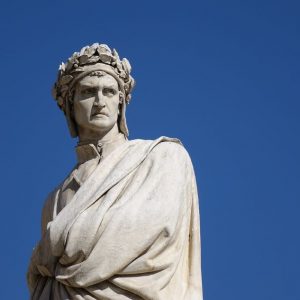Giovanni Boccaccio, born on 16th June 1313 in Certaldo, Florence, is one of Italy’s greatest writers and a pivotal figure of the Renaissance.
Boccaccio’s most renowned work, The Decameron, not only established his reputation but also had a profound influence on European literature.
Early Life and Education
Boccaccio was the son of a wealthy merchant, Boccaccino di Chellino, and an unknown woman. Likely, he was born out of wedlock. He received a comprehensive education that included both commercial training and humanistic studies. His early exposure to classical literature, including the works of Dante, and the intellectual milieu of Florence undoubtedly shaped his literary ambitions.
Literary Career
Boccaccio’s early works reflect his diverse interests and talents. His writings from this period include romances and poetry, such as Filostrato and Teseida, which display his mastery of narrative and lyrical forms. These were the models for Chaucer’s Troilus and Criseyde and The Knight’s Tale, respectively.
However, it was The Decameron, completed around 1353, that secured his place in literary history.
The Decameron
The Decameron is a collection of 100 tales told by ten young people (seven women and three men) who have fled Florence to escape the Black Death. The city was badly affected by the 1348 plague which killed around three-quarters of the population.
Over ten days, each member of the group tells a story each night, exploring themes of love, fortune, wit, and the human condition. The structure of the work is innovative, blending elements of classical and contemporary storytelling.
Boccaccio’s portrayal of the plague-ridden world is both realistic and humanistic, highlighting the resilience and folly of humanity. His tales range from the humorous and bawdy to the tragic and profound, with vividly drawn characters.
The Decameron also provides a valuable social commentary on 14th-century Italian society, offering insights into the lives and values of people from various social strata. It was Boccaccio’s last significant contribution to literature and one of his final works written in the Tuscan vernacular, with the only other major work being Corbaccio, dated to either 1355 or 1365.
Boccaccio undertook a thorough revision and rewriting of The Decameron between 1370 and 1371.
Influence and Legacy
Boccaccio’s influence on literature is immense. The Decameron served as a model for later writers, including Geoffrey Chaucer, whose Canterbury Tales mirrors Boccaccio’s framework of a story within a story.
Boccaccio’s use of the Italian vernacular rather than Latin was also significant, helping to elevate the status of the Italian language in literature.
Beyond The Decameron Boccaccio wrote extensively in both Latin and Italian. His other notable works include De mulieribus claris (On Famous Women), a collection of biographies of historical and mythological women, and Genealogia deorum gentilium (Genealogy of the Pagan Gods), which provided an extensive reference on classical mythology.
Later Life and Contributions to Humanism
In his later years, Boccaccio turned increasingly towards scholarship and humanism. He was a key figure in the early humanist movement, advocating for the study of classical texts and the liberal arts. Boccaccio maintained friendships with other prominent humanists, such as Petrarch, with whom he shared a lifelong correspondence that enriched both their intellectual pursuits.
Boccaccio’s dedication to the revival of classical antiquity and his contributions to the Renaissance humanist movement are noteworthy. He spent considerable time compiling and translating ancient texts, preserving knowledge that might have otherwise been lost to history.
Death and Posthumous Recognition
Giovanni Boccaccio died in 1375 in Certaldo, leaving behind a rich legacy that would inspire countless generations of writers and thinkers. His works continue to be read and revered, cementing his status as a foundational figure in Western literature.
Today, we remember Boccaccio not only for his storytelling prowess but also for his role in bridging the medieval and Renaissance worlds. His ability to capture the complexities of human experience with empathy, humour, and insight ensures his works remain relevant and compelling.






